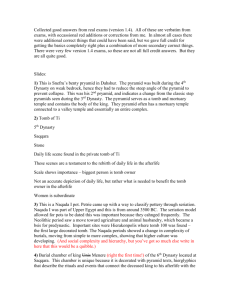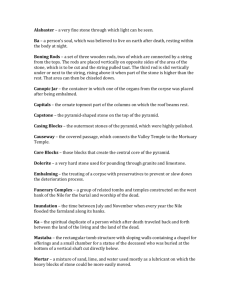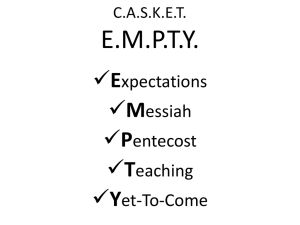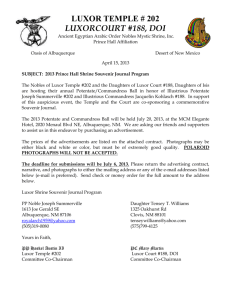The Treasures of the Nile
advertisement
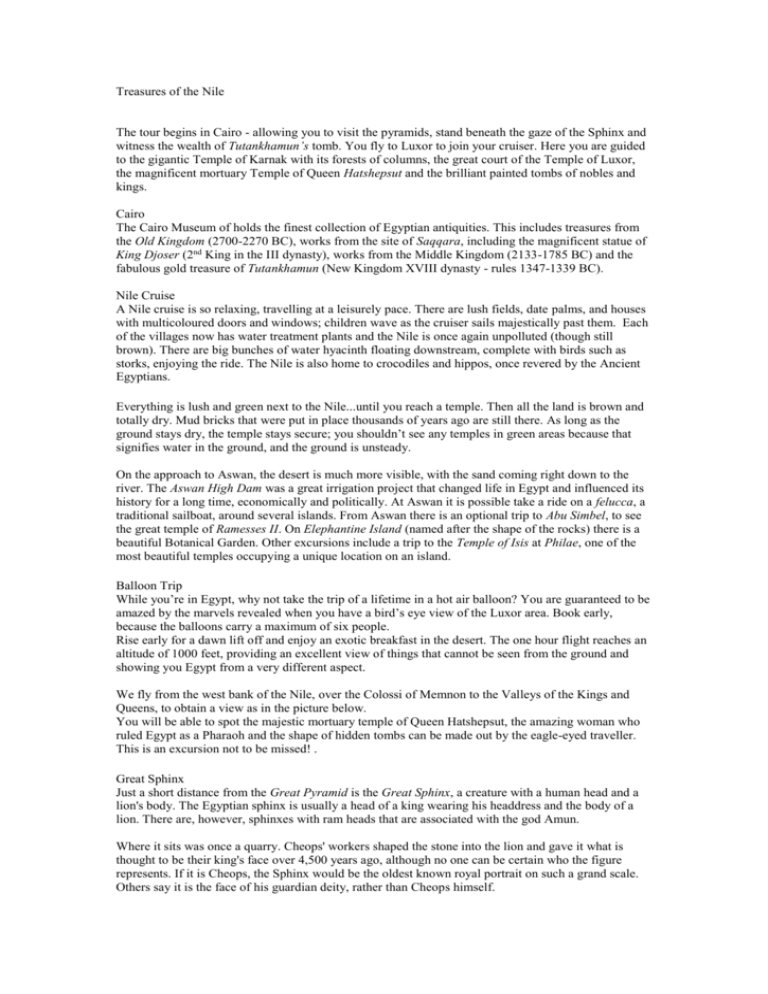
Treasures of the Nile The tour begins in Cairo - allowing you to visit the pyramids, stand beneath the gaze of the Sphinx and witness the wealth of Tutankhamun’s tomb. You fly to Luxor to join your cruiser. Here you are guided to the gigantic Temple of Karnak with its forests of columns, the great court of the Temple of Luxor, the magnificent mortuary Temple of Queen Hatshepsut and the brilliant painted tombs of nobles and kings. Cairo The Cairo Museum of holds the finest collection of Egyptian antiquities. This includes treasures from the Old Kingdom (2700-2270 BC), works from the site of Saqqara, including the magnificent statue of King Djoser (2nd King in the III dynasty), works from the Middle Kingdom (2133-1785 BC) and the fabulous gold treasure of Tutankhamun (New Kingdom XVIII dynasty - rules 1347-1339 BC). Nile Cruise A Nile cruise is so relaxing, travelling at a leisurely pace. There are lush fields, date palms, and houses with multicoloured doors and windows; children wave as the cruiser sails majestically past them. Each of the villages now has water treatment plants and the Nile is once again unpolluted (though still brown). There are big bunches of water hyacinth floating downstream, complete with birds such as storks, enjoying the ride. The Nile is also home to crocodiles and hippos, once revered by the Ancient Egyptians. Everything is lush and green next to the Nile...until you reach a temple. Then all the land is brown and totally dry. Mud bricks that were put in place thousands of years ago are still there. As long as the ground stays dry, the temple stays secure; you shouldn’t see any temples in green areas because that signifies water in the ground, and the ground is unsteady. On the approach to Aswan, the desert is much more visible, with the sand coming right down to the river. The Aswan High Dam was a great irrigation project that changed life in Egypt and influenced its history for a long time, economically and politically. At Aswan it is possible take a ride on a felucca, a traditional sailboat, around several islands. From Aswan there is an optional trip to Abu Simbel, to see the great temple of Ramesses II. On Elephantine Island (named after the shape of the rocks) there is a beautiful Botanical Garden. Other excursions include a trip to the Temple of Isis at Philae, one of the most beautiful temples occupying a unique location on an island. Balloon Trip While you’re in Egypt, why not take the trip of a lifetime in a hot air balloon? You are guaranteed to be amazed by the marvels revealed when you have a bird’s eye view of the Luxor area. Book early, because the balloons carry a maximum of six people. Rise early for a dawn lift off and enjoy an exotic breakfast in the desert. The one hour flight reaches an altitude of 1000 feet, providing an excellent view of things that cannot be seen from the ground and showing you Egypt from a very different aspect. We fly from the west bank of the Nile, over the Colossi of Memnon to the Valleys of the Kings and Queens, to obtain a view as in the picture below. You will be able to spot the majestic mortuary temple of Queen Hatshepsut, the amazing woman who ruled Egypt as a Pharaoh and the shape of hidden tombs can be made out by the eagle-eyed traveller. This is an excursion not to be missed! . Great Sphinx Just a short distance from the Great Pyramid is the Great Sphinx, a creature with a human head and a lion's body. The Egyptian sphinx is usually a head of a king wearing his headdress and the body of a lion. There are, however, sphinxes with ram heads that are associated with the god Amun. Where it sits was once a quarry. Cheops' workers shaped the stone into the lion and gave it what is thought to be their king's face over 4,500 years ago, although no one can be certain who the figure represents. If it is Cheops, the Sphinx would be the oldest known royal portrait on such a grand scale. Others say it is the face of his guardian deity, rather than Cheops himself. The sphinx faces the rising sun with a temple to the front. The figure was buried for most of its life in the sand, which is fortunate, because the sphinx is built of soft sandstone and would have disappeared long ago had it not been buried. The body is 200 feet (60m) in length and 65 feet (20m) tall. The face of the sphinx is 13 feet (4m) wide and its eyes are 6 feet (2m) high. The statue is crumbling today because of the wind, humidity and the smog from Cairo. Attempts to restore it have often caused more harm than good. Present attempts at restoration are under the control of the Supreme Council of Antiquities' archaeologists. They are concentrating on draining away subsoil seepage, which is damaging the rock. They are also repairing the damaged shoulder with smaller blocks and staying with the original size. Great Pyramid After a travelling through the Cairo suburbs to Giza and after a short camel ride you arrive at the largest and most famous of Egypt’s many pyramids, The Great Pyramid of Cheops. How the Great Pyramid was built is a question that may never be answered. Some believe slave labour was used, but another theory is that peasants, who were unable to work the land while the Nile flooded between July and November, built it. They may have been paid with food for their labour. The flooded waters would have helped to move the casing stones. These stones were brought from Aswan and Tura and the water would have brought the stones right to the pyramid. The encasing marble which covered the outside of the pyramid has eroded or been removed over time. This pyramid is thought to have been built between 2589 - 2566 BC and is estimated to be composed of over 2,000,000 blocks of stone, with an average weight of 2.5 tons each. At a total weight of 6,000,000 tons and a height of 482 feet (140m), it is the largest and the oldest of the Pyramids of Giza. Not much is known about Cheops (Khufu), because the tomb had been robbed long before archeologists came upon it. Any information about him was taken with the objects inside the tomb. He is thought to have been the ruler of a highly structured society and he must have been very wealthy. He was buried alone in this massive tomb. His wives may have been buried nearby in smaller mastabas. Inside the pyramid are ascending and descending passageways, both set at a 26 degree angle, only 3'6" (1.1m) wide and 3'11" (1.2m) high. At the levelling off point of the ascending passage, is the Grand Gallery. The gallery is 157 feet (48m) long and 28 feet (8.5m) high and is at the same 26 degree angle as the passages. The roof of the gallery is corbelled. It is said that not a piece of paper or a needle can be inserted between the stones making up the roof. The gallery is only 62 inches (1.6m) wide at the bottom and is only 41 inches (1m) wide at the top of the incline. The Grand Gallery leads into the King's Chamber. The walls of the chamber are made of pink Aswan granite. Inside this chamber is the very large sarcophagus made of Aswan red granite, with no lid. The sarcophagus must have been placed inside the chamber as the pyramid was being built. It is much too large to have been moved in afterwards, as was the usual custom of that time. Karnak/Luxor The Temples of Karnak and Luxor are ruins, perhaps the most wonderful of any to be found in Egypt. The Great Temple of Amun fronted the Nile and was approached by means of a small avenue of Sphinx. Passing through the first pylon into a court or hail, on the left is a small temple built by Seti II (New Kingdom XIX dynasty - ruled 1214-1208 BC) and on the right one built by Ramesses III (New Kingdom XX dynasty - ruled 1182-1151 BC). At the entrance leading through the second pylon are two colossal statues of pharaohs, one on each side. Continuing through the pylon you enter the famous hall of columns. Work here began under Seti I (New Kingdom XIX dynasty - ruled 1309-1291 BC) and was completed by his son Ramesses II (New Kingdom XIX dynasty - ruled 1290-1224 BC). Nearby you will see one of the two obelisks erected by Queen Hatsheput (New Kingdom XVIII dynasty - ruled 1490-1468 BC). They were set up in honour of Amun. A short distance away is Luxor. The Temple of Luxor was built mainly by Amenophis III (New Kingdom XVIII dynasty - ruled 1405-1367 BC) and Ramesses II, this grand temple must have been on eof the finest in Egypt. Although of lesser importance than Karnak, it played a major part in the worship of the Theban Triad - Amun Ra (Sun God), his wife Mut and their son Khonosu (Moon God). Hewn out of solid granite and situated in front of the great pylon, is an elegant obelisk, nearly 82 feet high, one of a pair whose companion now stands in the Place de la Concorde in Paris. Valleys of the Queens and Kings Necropolis of Thebes. The sun that sets on the West Bank of the Nile marks the traditional burial ground of the Pharaohs, their Queens and families. After crossing the Nile, you pass through the sugar plantations, then into the acrid desert to the stillness of the Valley of the Kings with the awe-inspiring tombs of the Pharaohs. The king's formal names and titles are inscribed in his tomb along with his images and statues. Beginning with the 18th Dynasty and ending with the 20th, the kings abandoned the Memphis area and built their tombs in Thebes. Also abandoned were the pyramid style tombs. Most of the tombs were cut into the limestone following a similar pattern: three corridors, an antechamber and a sunken sarcophagus chamber. These catacombs were harder to rob and were more easily concealed. Construction usually lasted six years, beginning with the new reign. Continue to the Temple of Queen Hatshepsut (New Kingdom XVIII dynasty - ruled 1490-1468 BC). This great mortuary temple is built on a grand scale, in a series of terraces with stark colonnades, it blends beautifully with the mountainside. On to the Valley of the Queens to view the tomb of the son of Ramesses III (New Kingdom XX), which vividly depicts the Pharaoh introducing his son the deities. There are between 75 and 80 tombs in the Valley of the Queens. These belong to Queens of the 18th, 19th and 20th Dynasties.
